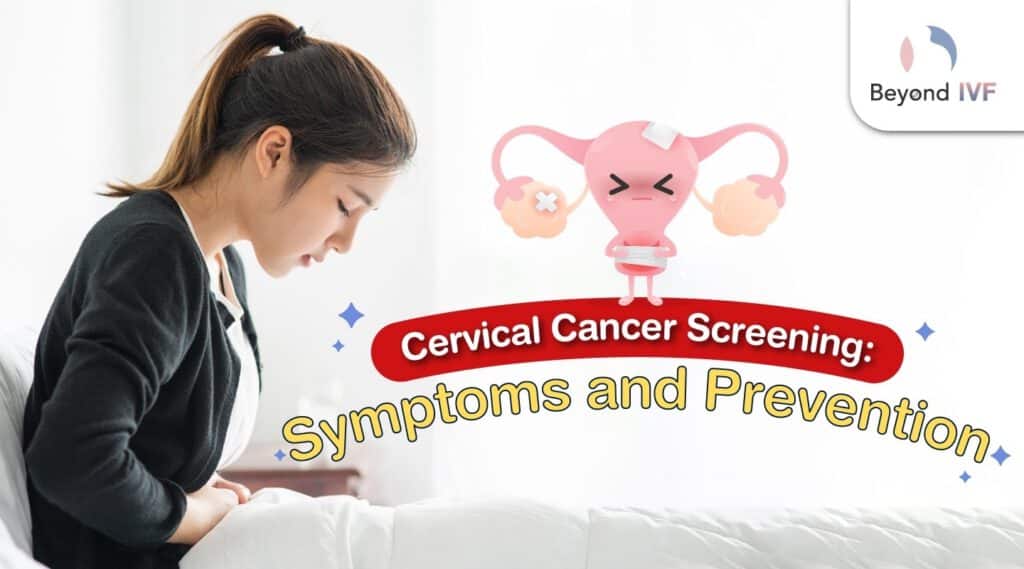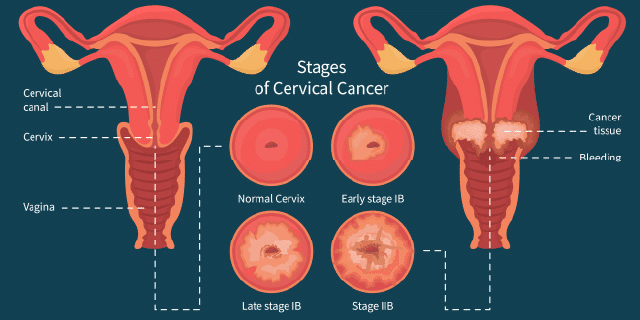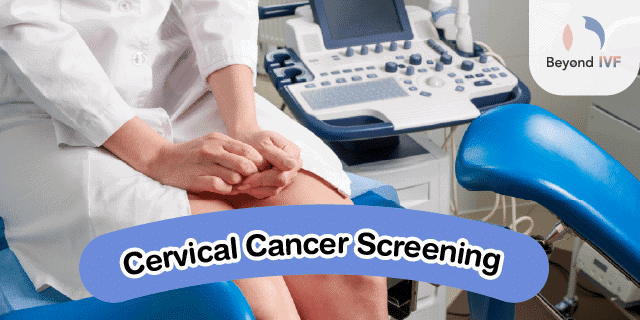
HPV, or the human papillomavirus, a leading cause in cervical cancer, claims more than 6 women a day in Thailand, or more than 2,200 women per year. These are sobering statistics, but a solution exists in the form of the HPV vaccine, which is recommended in women up to the age of 26.
Get to Know ‘Cervical Cancer’

Cervical cancer occurs in the cells of the cervix, the lower end of the uterus and the top of the vaginal. Most cases of cervical cancer are caused by the human papillomavirus or HPV, which is often sexually transmitted.
When HPV is first transmitted, the body’s immune response will defend it from infection. However, HPV can cause the cells of the cervix to become abnormal and develop into cancerous cells ultimately. Screening for cervical cancer and the HPV vaccine can reduce the risk of cervical cancer.
4 Stages of Cervical Cancer
Cervical carcinoma in situ refers to cancerous cells that are confined to the surface of the cervix and that haven’t penetrated more deeply into the tissues. At this stage there are no symptoms and cancer Is detected through cervical cancer screening called a Pap smear or Pap test.
There are four stages of invasive cervical cancer as follows:
- Stage 1: Cancer cells are confined to the cervix
- Stage 2: Cancer cells have spread to surrounding tissue, like the top of the vagina or the tissue next to the cervix
- Stage 3: Cancer cells have spread to nearby tissue, such as the bottom part of the vaginal, lymph nodes, and other tissue in the pelvis
- Stage 4: Cancer cells have spread to the bladder, bowels, or outside the pelvis, including the lungs, liver, and/or bones
Causes of Cervical Cancer
The human papillomavirus (HPV) that causes cervical cancer is not passed on genetically, but mainly through sex. Males are the main carriers even though they do not have cervixes.
Risk Factors for Cervical Cancer

These are the risk factors for cervical cancer include
- Having multiple sexual partners or changing sexual partners often
- Becoming sexually active when young
- Being diagnosed with other sexually transmitted infections, such as chlamydia, gonorrhea, syphilis, and HIV/AIDS
- Immunocompromised people are at higher risk of having cervical cancer than healthy people
- Smoking
- Taking oral birth control for more than five years
- Giving birth to more than one child
Symptoms of Cervical Cancer
Early-stage cervical cancer often has no symptoms. Later stage cervical cancer may cause the following symptoms:
- Vaginal bleeding after sexual intercourse
- Abnormal vaginal discharge
- Lighter or heavier than normal period
- Pain during sexual intercourse
- Vaginal bleeding during menopause
- Fatigue, paleness, loss of appetite, unexplained weight loss
- Swelling
- Inability to urinate or control urine
- Pain in the lower abdomen
When cervical cancer has metastasized, symptoms may include swelling in both legs due to lymph nodes being obstructed, and/or blood in urine or stool due to cancer in the ureters or bowels.
Cervical Cancer Screening

- Pap smear: Tissue around the cervix is collected by the doctor and examined in the laboratory. This procedure is painless and involves touching a long, thin swab to the cervix.
- Thin Prep test: A more developed version of the test that allows for more accurate diagnosis.
Why is cervical cancer screening important?
Almost all cases of cervical cancer are caused by the high-risk type of the human papillomavirus (HPV) that is sexually transmitted.
Cervical cancer screening is an important tool for prevention. Sexually active women should be screened regularly and those who are not sexually active should begin screening after 30 years of age.
Types of Cervical Cancer Screening
1. Pap Smear
Pap smear: involves the use of a swab to collect cells around the cervix to be examined in the laboratory. This is a test that has been done for a long time.
2. ThinPrep
Pap test: has been developed from the Pap smear and is more effective and accurate. Cells around the cervix are collected with a specific tool and then placed in a prep solution before it is sent to the laboratory.
EITHER A PAP SMEAR OR A THIN PREP TEST IS RECOMMENDED AT LEAST ONCE PER YEAR.
3. Co-testing
DNA-level cervical cancer screening: with Thin Prep Plus Cervista HPV DNA Testing combines looking for cervical cancer cells with checking the DNA of the HPV strains that relate to cervical cancer as well as checking if here is an infection of HPV 16 or HPV 18.
This provides information about the risk of disease. The best time for cervical cancer screening is the 10 days in the middle. We divide each month into three sections of 10 days each and the first day of a period is considered day 1 and day 11-20 after the first day of a period is when results are most accurate and considered the best time for cervical cancer screening.
Who Should Go for Cervical Cancer Screening
The candidates for cerc=vical cancer screening include
- Women who are sexually active
- Women older than 30
- People who are immunocompromised
- People who have multiple sexual partners
Preparing for Cervical Cancer Screening
Regardless of the screening method, cells around the cervix have to be collected, but the method of analysis is different with each method. So whatever the screening method, preparation is the same, as follows:
- You can eat and drink normally before cervical cancer screening.
- Wear clothing that you can remove comfortably as you will need to change into the provided clothing before the procedure.
- Screening should not be done while you have a period and it is recommended to undergo screening at least seven days before or after a period.
- Avoid sexual intercourse 48 hours before the screening and avoid using lubricant, sprays, powders, or vaginal suppositories. Avoid douching.
- Cervical cancer screening is safe and has no side effects. You can resume normal activities after the procedure.
Cervical Cancer Screening Process
Pap smear
- The doctor will insert equipment into the vaginal.
- The doctor will examine the vagina and collect cells from the cervix with a swab to be sent to the laboratory.
- The sample will be analyzed and the doctor will interpret the results.
Pap test
- The doctor will use a small brush to collect cells from the cervix.
- The head of the brush will be placed into a solution to preserve the cells and the sample is sent to the laboratory.
- The sample will be analyzed and the doctor will interpret the results.
DNA-level cervical cancer screening
- The doctor will collect cells from around the cervix and the vagina with a swab and the swab will be stored in a specific HPV DNA test solution.
- The sample will be analyzed in the laboratory and the doctor will interpret the results.
Cervical Cancer Test Results
Cervical cancer can be prevented by receiving the HPV vaccine between the ages of 11-12, though the vaccine can be given as early as 9 years old. However, if you are diagnosed with cervical cancer, there are many options for treatment, including surgery, radiation, and chemotherapy, whether on their own or in combination.
Cervical Cancer Treatments
1. Surgery
In early stage cervical cancer the doctor may recommend surgery as the main treatment. A radical hysterectomy is often the recommended treatment, removing the cervix, uterus, the top of the vagina, and nearby tissues and lymph nodes in the pelvis.
If the cancer is very small, the doctor may recommend a simple hysterectomy instead. If the patient wishes to have children in the future, a treatment option may be a trachelectomy, which keeps the uterus. All treatment options should be discussed with the doctor to weigh risks and benefits.
2. Radiation Therapy
If the biopsy reveals that there is a high risk of recurrence the doctor may recommend radiation as an additional treatment after surgery. For locally advanced cervical cancer doctors commonly recommend radiation with chemotherapy as the main treatment.
There are two types of radiation therapy: external beam therapy and brachytherapy. External beam therapy involves a radiation machine that targets radiation beams to specific locations. With brachytherapy, radiation seeds are placed in the patient’s abdomen for a short period of time.
Radiation may lead to premature menopause so it is important to discuss egg freezing before treatment, especially when the patient is young or would like to have children in the future.
3. Chemotherapy
Chemotherapy drugs destroy cancer cells. The doctor will try to use as little chemotherapy as possible in combination with radiation for locally advanced disease. Chemotherapy, in this instance, increases the efficacy of radiation therapy.
However, in the case of metastatic disease that has spread to other parts of the body, chemotherapy is often the main treatment option.
Cervical Cancer Prevention
1. Avoiding Risk Factors
Avoid carcinogens and risk factors for cervical cancer, including:
- Avoid having multiple sexual partners
- Avoid sex when very young
- Use condoms
- Avoid other sexually transmitted infections, especially HPV
- Avoid smoking
- Receive the HPV vaccine
2. Cervical Cancer Check
Normally cervical cancer screening should begin at 30 years of age, but can be started as early as 25 as appropriate, and should be done every two to three years.
After three consecutive normal results, if you have no history of cancer in situ and have no problems with your immune system, screening can be repeated every 3-5 years.
If immunocompromised, cervical cancer screening should be done every six months in the first year after diagnosis of the immune system disease and once a year after that.
However, the frequency of screening may change depending on what is appropriate in those specific circumstances. For example, if there are high rates of cervical cancer in your community, screening is recommended annually.
3. Getting HPV Vaccines
Cervical cancer prevention through the HPV Vaccine (3 injections total)
Vaccination Schedule
- 1st vaccination shot can be scheduled as per the patient’s convenience
- 2nd vaccination shot within 1-2 months of the first
- 3rd and final vaccination shot within 6 months of the first
Q&A for Cervical Cancer Screening
Is it painful to test for cervical cancer?
Cervical cancer screening is not painful. Thin prep test involves collecting cells around the cervix in a liquid to look for cancer cells. The procedure takes 15-20 minutes and results are usually available 2-3 weeks after the collection.
Do I still require cervical cancer screening after a hysterectomy?
If you had a hysterectomy due to cervical cancer, you should still have regular Pap tests to check for recurrence. If you had a hysterectomy unrelated to cervical cancer, you should have a Pap test every 2-3 years.
Does HPV always lead to cervical cancer?
HPV does not always lead to cervical cancer. The United States Center for Disease Control (CDC) found that mucosal HPV can be divided into two categories: milk and severe. The milder virus can lead to sores around the genitals and anus on in the mouth and neck. More than 90% of genital herpes is caused by HPV 6 and 11.
Final Thoughts
Cervical cancer is a common cancer found in women, an abnormality of cells around the cervix. It can be found at an early stage with regular pelvic exams and cervical cancer screenings. In its earliest stage cervical cancer has no symptoms, and symptoms often occur when the cancer has progressed.
Most cervical cancer is caused by various strains of HPV that can cause infection around the genitals of both men and women, especially HPV 16 and 18, which are the main causes of cervical cancer. Sexually active people are at higher risk, whether monogamous or with multiple sexual partners. However, the more partners you have, the higher the risk of contracting HPV.
If you have any questions, please contact us on Line at @beyondivf








